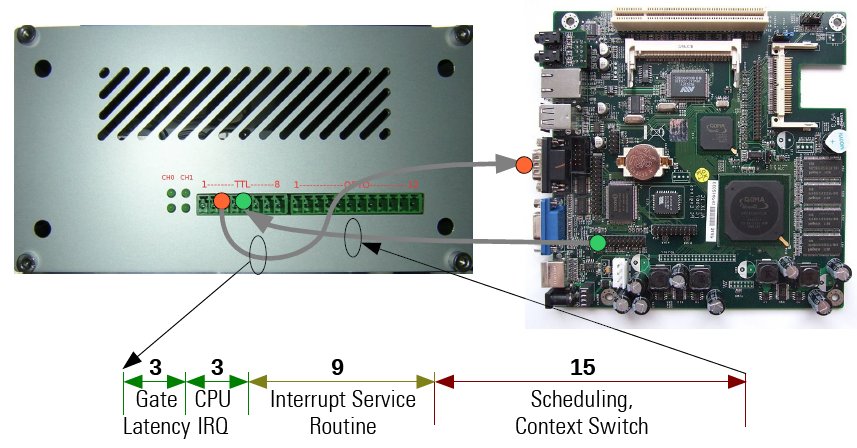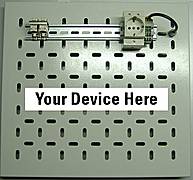Dates and Events:
|
OSADL Articles:
2023-11-12 12:00
Open Source License Obligations Checklists even better nowImport the checklists to other tools, create context diffs and merged lists
2022-07-11 12:00
Call for participation in phase #4 of Open Source OPC UA open62541 support projectLetter of Intent fulfills wish list from recent survey
2022-01-13 12:00
Phase #3 of OSADL project on OPC UA PubSub over TSN successfully completedAnother important milestone on the way to interoperable Open Source real-time Ethernet has been reached
2021-02-09 12:00
Open Source OPC UA PubSub over TSN project phase #3 launchedLetter of Intent with call for participation is now available |
Linux QA: We take care of hardware, too
The OSADL Test Rack and the OSADL Latency Box help to ensure continuous high quality of the Linux kernel
Did you ever wonder why it is taking us always so long to release a "Latest Stable" Linux kernel? Here is the simple answer: Because we want it to be as stable as possible and production ready for a large variety of systems. This includes, of course, the many platforms and architectures that are used in embedded systems and in the machine and automation industry. Taking care of all these systems was always a lot of hassle, since not even two of them come with identical serial and power connectors and pin assignments, and some of them even have unique power requirements.
Fortunately, this has now become a lot easier: The OSADL Test Rack is here.
The OSADL Test Rack (project page)
Thanks to kernel developer Thomas Gleixner's skills as a hardware engineer, we have now a modular test rack that can eat up to eight embedded systems on individual removable test tablets, or eight standard PCs, or four of each. Every system is connected to a remotely switchable power supply, has network access via a manageable switch and can be operated using the serial port via a terminal server. In addition, the removable test tablets are equipped with a DIN rail (see top right picture, click on it or click here to display it at a higher resolution).
 Important design features are:
Important design features are:
- The tablets can be removed easily and individually and can be used on the desk, whenever necessary.
- The connectors, pin assignments, and the electrical and logical specifications of the interfaces are standardized to avoid any hassle with a company's in-house serial and power connectors and exotic power requirements.
There are several scenarios how the OSADL Test Rack and test tablets are used:
- Currently, three racks with a total of 24 systems (but soon more) are running at Linutronix. Every time, a new release candidate of a Linux kernel is produced, it will be compiled for all systems and run on all of them to detect regressions. Automatic test scripts are used for this purpose.
- OSADL member companies can purchase OSADL Test Racks and operate them within their facilities. Upon request, particular systems that are installed on such OSADL Test Racks can be included in the automatic testing of release candidate kernels. Remote operation is done via VPN over the Internet.
- OSADL member companies who have only a small number of boards to be tested can hire rack space and submit test tablets equipped with the boards to be tested which will then also be included in the automatic testing of release candidate kernels.
The advantages on both sides are evident: Future "Latest Stable" kernels will be more stable than ever, and a participating company can upgrade to a new kernel version much easier than before whenever they wish. Or in other words: Regressions of the kernel during its development will be fixed shortly after they are produced and not at any later time when there is no longer a reasonable temporal relationship between a patch and a regression.
Further details are given on the project page of the OSADL Test Rack.
The OSADL Latency Measurement Box (project page)
The OSADL Latency Measurement Box is our second project that deals with hardware instead of software. Why? In addition to testing the internal worst-case latency using the kernel built-in<media 3626 _blank> </media> histograms or test programs such as cyclictest, it is necessary to determine the external overall worst-case latency of a system from time to time. Normally, this is done with a digital oscilloscope, but the results are often difficult to read - especially when a large number of single measurements over a long test period is gained. In addition, a separate trigger generator is necessary. OSADL has, therefore, commissioned a latency measurement device that is equipped with two trigger and two measurement channels and can be used to determine the external overall worst-case latency of a system without requiring any additional equipment. OSADL's Gold member Eltec Elektronik AG in Mainz, Germany, agreed to develop such systems which are now available on loan for OSADL members. More details are given on the related project page of the OSADL Latency Measurement Box; in addition, a Users' Manual (PDF format) is available.
</media> histograms or test programs such as cyclictest, it is necessary to determine the external overall worst-case latency of a system from time to time. Normally, this is done with a digital oscilloscope, but the results are often difficult to read - especially when a large number of single measurements over a long test period is gained. In addition, a separate trigger generator is necessary. OSADL has, therefore, commissioned a latency measurement device that is equipped with two trigger and two measurement channels and can be used to determine the external overall worst-case latency of a system without requiring any additional equipment. OSADL's Gold member Eltec Elektronik AG in Mainz, Germany, agreed to develop such systems which are now available on loan for OSADL members. More details are given on the related project page of the OSADL Latency Measurement Box; in addition, a Users' Manual (PDF format) is available.
If you are not (yet) an OSADL member but you would like to participate at the OSADL Test Rack program or use the OSADL Latency Measurement Box, please let us know. We'll try to find a solution.





